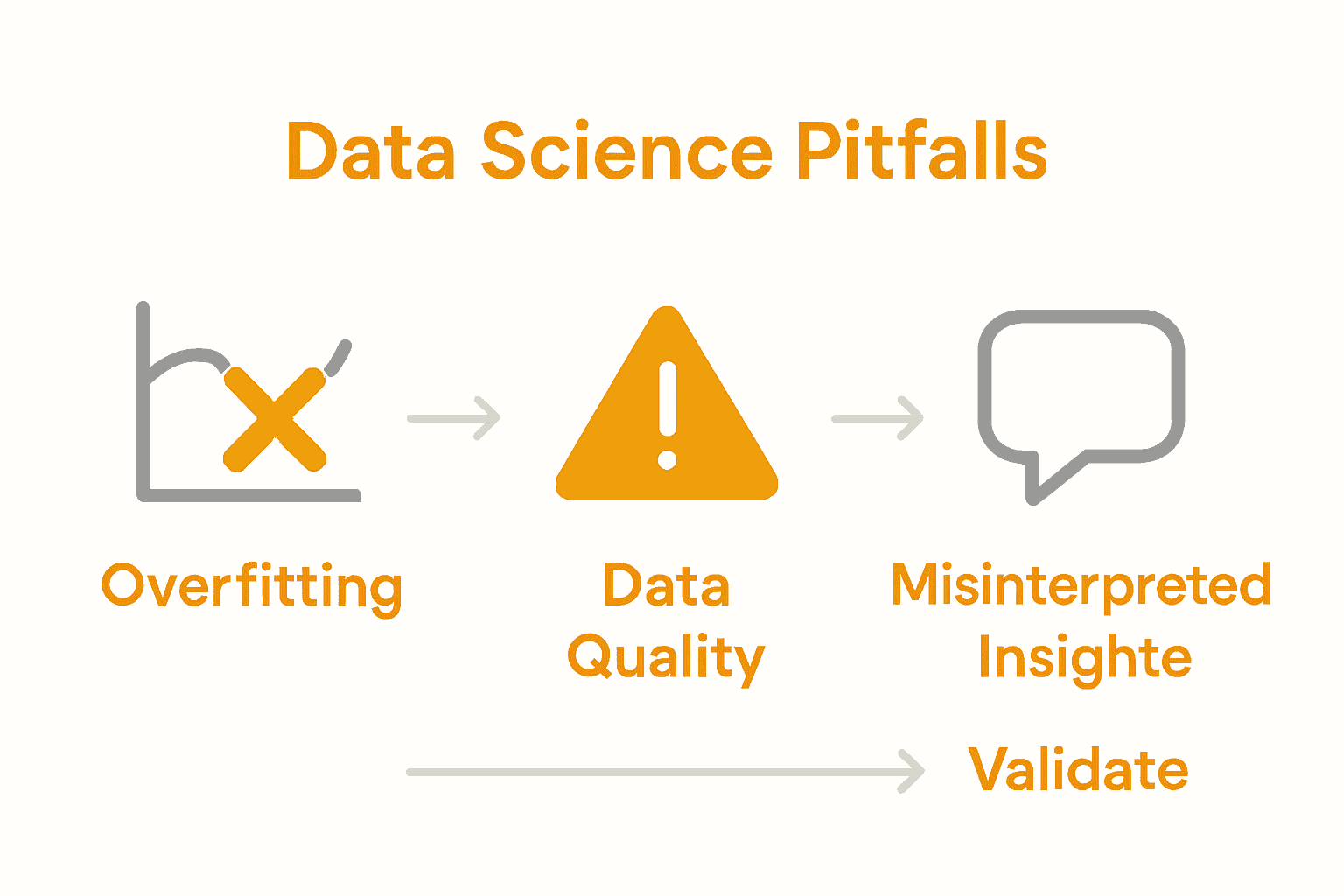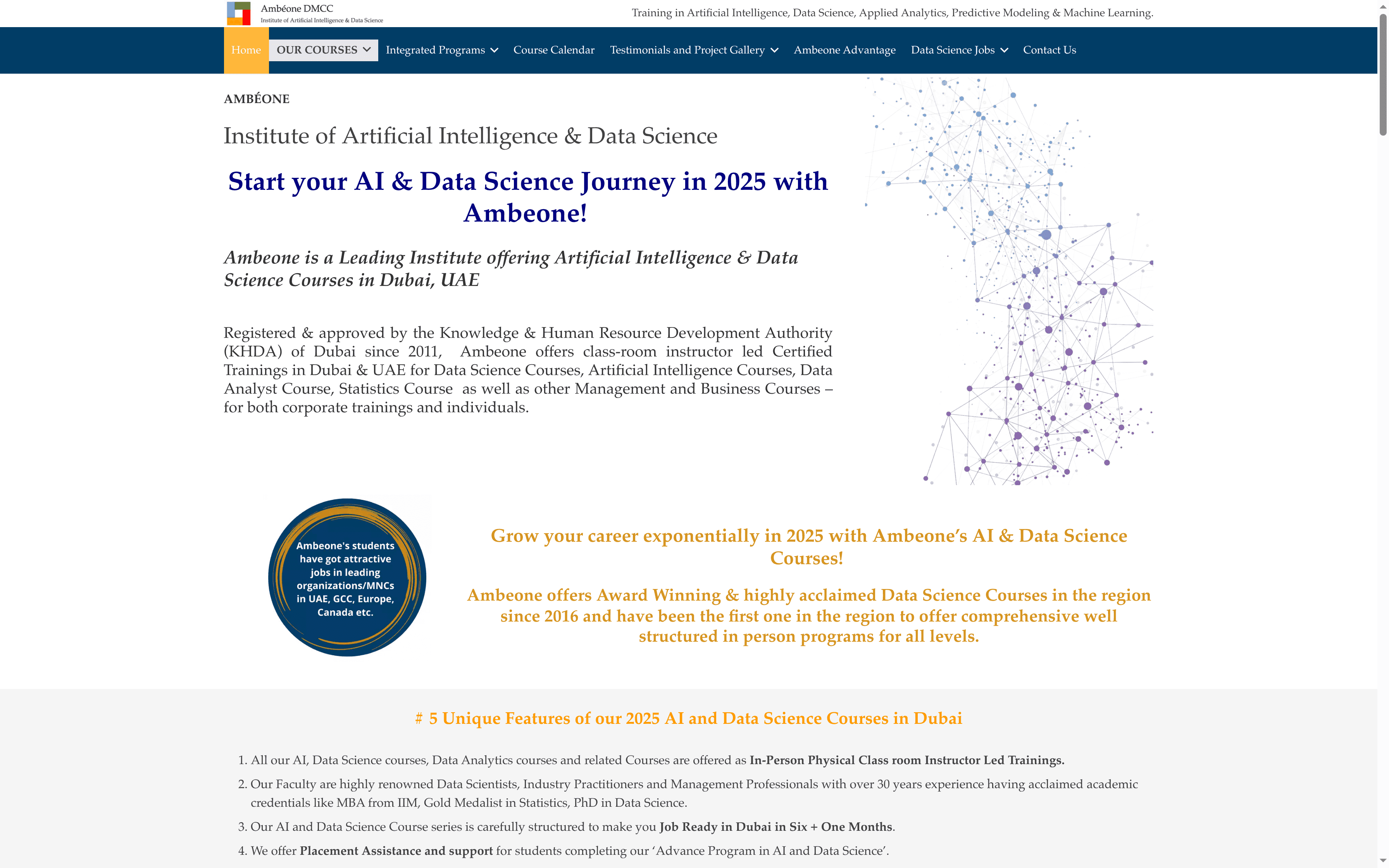Complete Guide to Data Science for Managers
Over 60 percent of global companies say data drives key business decisions, yet many leaders still feel uncertain about what data science really means for their organizations. As technology reshapes every industry, knowing how to turn complex information into clear actions sets successful businesses apart. This article explains what data science is, why it matters for american business leaders, and how understanding its practical uses can help transform raw numbers into real, competitive advantages.
Table of Contents
- Defining Data Science For Business Leaders
- Types Of Data Science Applications In Management
- Essential Skills And Mindsets For Managers
- Integrating Data Science Into Decision-Making
- Common Pitfalls And How To Avoid Them
Key Takeaways
| Point | Details |
|---|---|
| Multidisciplinary Approach | Data science merges statistics, programming, and business strategy to enhance decision-making. |
| Operational Efficiency | It enables managers to optimize processes, predict bottlenecks, and enhance productivity through advanced analytics. |
| Data-Driven Decision-Making | Organizations should adopt structured frameworks, such as CRISP-DM, for integrating data insights into strategic planning. |
| Common Pitfalls Awareness | Address potential challenges like model overfitting and data quality issues to maintain effective data science implementations. |
Defining Data Science for Business Leaders
Data science is a transformative discipline that bridges technical expertise with strategic business decision-making. According to Wikipedia, it represents an interdisciplinary field combining statistics, computer science, and domain expertise to extract actionable knowledge from complex data landscapes.
At its core, data science goes far beyond simple number-crunching. arXiv highlights that the discipline integrates scientific methodologies and sophisticated algorithms to analyze intricate data sets, enabling organizations to make precise, data-driven strategic choices. This approach empowers business leaders to transform raw information into meaningful insights that drive competitive advantage.
Key characteristics of data science for business leaders include:
- Multidisciplinary approach: Integrating skills from statistics, programming, and business strategy
- Advanced analytical techniques: Utilizing machine learning, predictive modeling, and big data analytics
- Strategic decision support: Translating complex data patterns into actionable business recommendations
- Technological integration: Leveraging cutting-edge tools and platforms to process and interpret large-scale datasets
For business leaders seeking to understand data science’s practical applications, seven ways data science transforms business operations can provide deeper insights into its strategic potential. Understanding these nuanced applications allows executives to effectively leverage data science as a powerful competitive tool in today’s rapidly evolving business environment.
Types of Data Science Applications in Management
In today’s competitive business landscape, data science has become a transformative tool for management professionals across multiple operational domains. Indeed highlights that data science enables managers to analyze large datasets strategically, identifying trends and predicting outcomes that drive organizational performance.
The primary applications of data science in management can be categorized into several critical areas. Operational efficiency represents a key domain where data science techniques provide profound insights. Managers can leverage advanced analytics to optimize workflow processes, predict potential bottlenecks, and streamline resource allocation. By implementing predictive models, organizations can significantly reduce operational costs and enhance overall productivity.

Key management applications of data science include:
- Risk Assessment: Developing sophisticated predictive models to identify potential financial and operational risks
- Market Analysis: Understanding customer behavior, market trends, and competitive landscapes
- Human Resources Management: Analyzing workforce performance, predicting talent retention, and optimizing recruitment strategies
- Financial Forecasting: Creating accurate financial projections and investment strategies
For managers looking to deepen their understanding of practical data science implementation, how data science techniques transform manufacturing processes offers valuable insights into real-world applications. By embracing these data-driven approaches, business leaders can make more informed decisions, anticipate challenges, and create sustainable competitive advantages in their respective industries.
Essential Skills and Mindsets for Managers
Data science demands a transformative approach to management that goes beyond traditional analytical methods. Wikipedia emphasizes that managers must develop sophisticated skills in data analysis, statistical modeling, and programming languages like R and Python to effectively leverage data-driven insights.
Beyond technical capabilities, arXiv highlights the critical importance of cultivating a data-driven mindset. This approach requires managers to embrace critical thinking, maintain intellectual curiosity, and demonstrate a willingness to challenge existing assumptions through empirical evidence. The most successful leaders view data not as a passive reporting tool, but as an active decision-making partner that can unlock unprecedented organizational potential.
Key skills and mindset characteristics for modern data-savvy managers include:
- Technical Proficiency: Understanding programming languages and statistical analysis tools
- Analytical Thinking: Ability to interpret complex data sets and extract meaningful insights
- Strategic Vision: Translating data insights into actionable business strategies
- Ethical Awareness: Understanding data privacy and responsible usage principles
- Continuous Learning: Commitment to staying updated with emerging technological trends
Managers seeking to enhance their data science capabilities can explore the essential guide to applied analytics applications to gain deeper insights into practical implementation strategies. By developing these skills and adopting a curious, adaptable mindset, business leaders can transform data from a simple reporting mechanism into a powerful strategic asset that drives organizational innovation and competitive advantage.
Integrating Data Science Into Decision-Making
Data-driven decision-making represents a fundamental shift in organizational strategy, transforming how businesses approach complex challenges. arXiv emphasizes the importance of adopting structured processes like the CRISP-DM framework, which provides a systematic approach to analyzing data and generating actionable insights aligned with core business objectives.
The integration of data science into decision-making extends far beyond simple data analysis. arXiv highlights the emerging power of prescriptive analytics, which not only predicts potential outcomes but also recommends specific actions to achieve desired results. This approach requires deep collaboration between data scientists and executive leadership, bridging the gap between complex analytical findings and strategic business initiatives.
Key strategies for successful data science integration include:
- Cross-functional Collaboration: Establishing communication channels between data teams and decision-makers
- Standardized Analytical Frameworks: Implementing consistent methodologies for data interpretation
- Continuous Learning: Creating feedback loops that refine analytical approaches
- Technology Infrastructure: Investing in robust data management and visualization tools
- Cultural Transformation: Promoting a data-driven mindset across organizational levels
Managers looking to deepen their understanding of data science implementation can explore Ambeone’s nine-step guide for building statistically robust data science projects, which offers comprehensive insights into developing effective analytical strategies. By embracing these principles, organizations can transform data from a passive reporting tool into a powerful strategic asset that drives innovation and competitive advantage.
Common Pitfalls and How to Avoid Them
Data science implementations are fraught with potential challenges that can undermine organizational effectiveness. arXiv reveals critical pitfalls that managers must vigilantly address, emphasizing the importance of rigorous model validation, data accuracy, and maintaining transparency throughout analytical processes.
One of the most significant risks in data science stems from misalignment between technical capabilities and business objectives. Wikipedia highlights that successful data science initiatives require establishing clear organizational goals, fostering robust communication between technical and business teams, and continuously monitoring the impact of data-driven decisions.
Key pitfalls and their strategic mitigation strategies include:
- Overfitting Models: Develop robust cross-validation techniques and maintain statistical rigor
- Data Quality Issues: Implement comprehensive data cleaning and validation protocols
- Misinterpreted Insights: Ensure interdisciplinary review of analytical findings
- Communication Gaps: Create structured collaboration frameworks between technical and business teams
- Ethical Blind Spots: Establish clear guidelines for responsible data usage and privacy protection
Managers seeking deeper understanding of data science project implementation can explore Ambeone’s nine-step guide for building statistically robust data science projects, which provides comprehensive strategies for navigating potential challenges. By anticipating and proactively addressing these common pitfalls, organizations can transform potential obstacles into opportunities for innovation and strategic growth.

Empower Your Management Career with Practical Data Science Skills
The “Complete Guide to Data Science for Managers” highlights how mastering data-driven decision-making, technical proficiency, and overcoming common implementation pitfalls are crucial challenges many managers face today. If you are looking to transform complex data insights into powerful business strategies while developing a strong data-driven mindset, you are not alone. This guide outlines the need for cross-functional collaboration and continuous learning — key themes that resonate with professionals eager to advance their careers in AI and data science.

Take the next step to bridge theory and real-world application by joining expert-led training at Ambeone, your trusted educational platform for Artificial Intelligence and Data Science in Dubai. Explore our range of in-person workshops, certifications, and corporate programs that focus on applied analytics and business-relevant data science techniques. Dive deeper into practical applications by visiting our Uncategorized Archives – Ambeone to access insights and resources tailored for managers. Start your journey today to become a confident data-savvy leader capable of driving innovation and outperforming the competition.
Frequently Asked Questions
What is the role of data science in business decision-making?
Data science plays a crucial role in business decision-making by leveraging advanced analytical techniques to transform complex data into actionable insights that drive strategic choices and competitive advantage.
What skills do managers need to effectively utilize data science?
Managers need a mix of technical proficiency in programming languages and statistical tools, analytical thinking, a strategic vision, and an ethical awareness regarding data usage as well as a commitment to continuous learning.
How can managers integrate data science into their organization?
Managers can integrate data science by fostering cross-functional collaboration, implementing standardized analytical frameworks, investing in technology infrastructure, and promoting a data-driven culture within their organization.
What are common pitfalls in data science implementations, and how can they be avoided?
Common pitfalls include overfitting models, data quality issues, misinterpreted insights, communication gaps, and ethical blind spots. These can be avoided by establishing comprehensive data validation protocols, maintaining interdisciplinary review processes, and creating structured communication frameworks.

